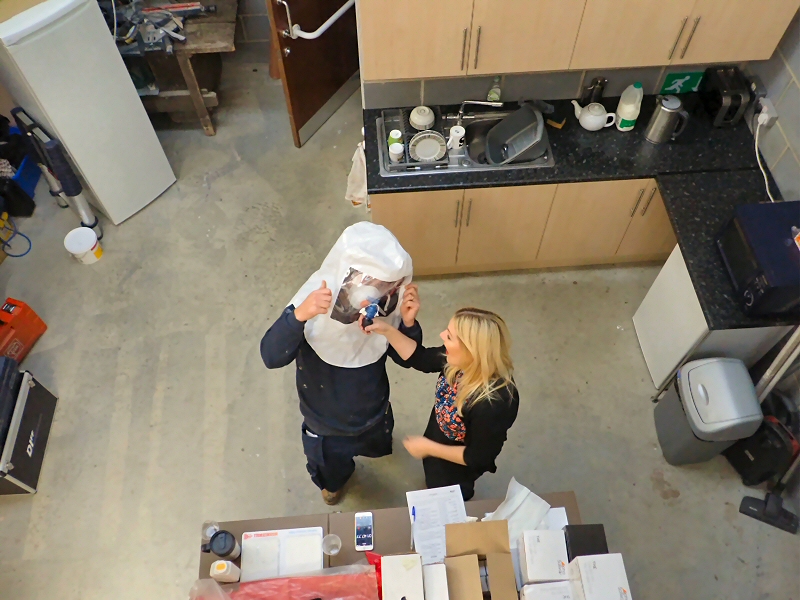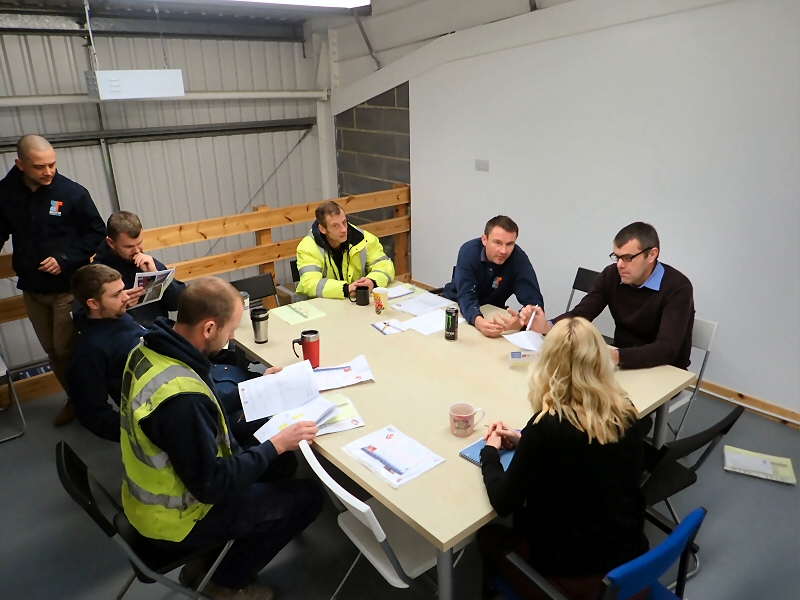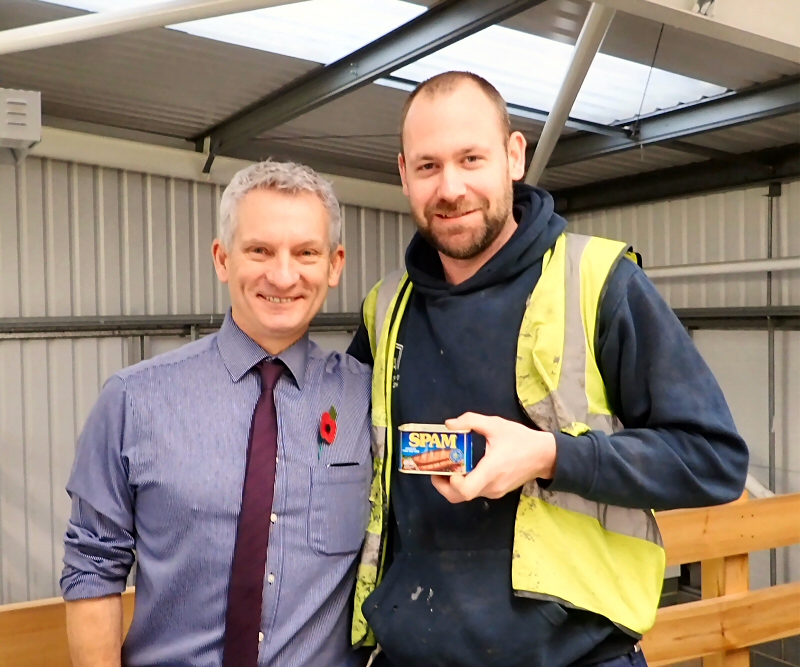Friday morning de-brief is a good time to observe how health and safety impacts during our week. This one was particularly illuminating for all of us.
Our day to day activities place stress on us to perform on lots of levels:
- Keeping the work flowing
- Make profit
- Cooperate with clients, contractors…. each other
- Avoid lost time and money
- Maintain our values
These things are the bread and butter of any business. Get them right and the business will thrive; but at what cost to health, safety and well-being?
Here’s a story from this week’s projects, illustrating how the natural willingness to help and ‘get on with work’ can be a real threat and potential danger to our team and others. Don’t worry, there’s a happy ending. In fact the episode demonstrates how a positive health and safety culture can take root in a business and improve health and safety outcomes at crucial moments.
Ryan and Adam were tasked with some structural repairs, installing some remedial wall ties through a commercial building façade in Leeds. As specialist sub-contractors, employed to do this work via a cherry picker (MEWP), we planned and organised the work with safety in mind. The work was 5M above ground level.
Things changed at short notice.
On arrival Ryan was told that the work had changed and now the main contractor simply wanted parts of the masonry taken down. The nature of the change meant that the MEWP couldn’t be used and a working platform was needed.
The client was a shop-fitting firm on a very tight program. Keen to help the client, I attended site immediately, a new risk assessment was drawn up on site and a tower scaffold brought into play. However, the presence of steel work meant that only a slim single man platform would fit alongside the masonry.
Time was passing and it was gone lunchtime when Ryan and Adam managed to obtain the access equipment and erect it. When Ryan was stood at eye level with the masonry he had a good view and could really see what the work would involve. The stones were much thicker than they looked from ground level and would need at least two men to safely remove them. He called me on the phone and I said “Oh no, isn’t there some way we can chip them around the edges and cut them into manageable sections?”
Ryan paused and then quietly said “No Bryan, if they come loose it could be dangerous and on my own I couldn’t stop a bit falling out”.
Deep rooted safety.
Of course what was needed was a pause and a complete reassessment of the situation. I told Ryan to stop work and tell the site manager that in order to carry out the work, a tube and fit scaffold, suitable for two workmen alongside the masonry was required.
The client was not pleased and made this obvious to me. He wanted the work doing now and was very demanding about it. I refused and recommended a structural engineer and the access mentioned earlier.
So on that day, on the face of it we achieved nothing; no production; a client unhappy with a delay and Ryan, feeling that he had let the firm down. He told one of his colleagues that he hoped I wasn’t upset because he couldn’t get the job done. I noticed an air of despondency, even failure…. An expensive MEWP on site, which we couldn’t use too.
Celebration.
The next day was our weekly de-brief. Each team reports to all about their week and what they learned from each project. Ryan told all that he had a ‘problem’ on the job in Leeds….
At this point I interjected and was able to explain that contrary to thoughts doing the rounds I was proud of Ryan and delighted with the way he and Adam handled the situation. I was also thankful to him for stepping in and doing the right thing.
I have spent the past few years trying to develop a positive health and safety culture in Brick-Tie. It is a never ending job. What the events this week show is that our culture is taking root as it matures. We all felt real pressure on site. We all wanted to help the client get the job done. There was a real chance that at the crucial moment that pressure could have resulted in a dangerous activity taking place. Ryan, Adam or another could have been hurt.
That threat was lifted by Ryan’s confidence in being able to speak his thoughts and by my willingness to listen. This is what a good safety culture needs to do – spread through every level of the business so that health and safety is everyone’s business and all can speak up.
Nevertheless, he was still a little worried about what his ‘boss’ thought. To be honest that worried me. This is why I needed to think carefully about what had almost happened. I analysed my part in it. I realised that when I wrote my on-site RA and method statement I didn’t allow for the fact that I was basing my assessment on a ‘ground level’ view. I did consult Ryan and Adam but they too were looking up at what we thought were thin, lightweight masonry units. I should have attended site again and made a further risk assessment once the platform was in place. That way Ryan would have the written instructions to do what he did automatically. I was wrong in not doing that, but Ryan saved me (and possibly himself) by doing his own assessment there and then – well done Ryan and thank you.
I also thought about how things can get out of hand when things change unexpectedly. This is a crucial moment on any job and the opportunity for things to go wrong. In this case it was obvious that Ryan and Adam felt the pressure to perform and get the job done. I played my part in applying that pressure without realising what I was doing. Ryan has been with me for many years; long before I got the health and safety bug. At our Friday de-brief we agreed that “back in the day he’d ‘av just done it.” So what has changed?
We’re much safer now
We are now a much safer place to work than we were in the noughties. We are not perfect, nobody is. Errors and omissions are part of life. This is why we need each other so that when the pressure is on and one of us drops the ball, his team mates have the training, motivation and confidence to pick it up.
It’s why Ryan was named a ‘Health and Safety hero’ this morning and it’s why I couldn’t get the grin of my face, even as I told the lads that I had made a serious mistake.
I’m so proud of my team and the real efforts they have put out into making Brick-Tie a safe place to work. They have cooperated with enthusiasm. It’s a slow and a never ending job, but the events this week show that it is working.

Friday brings everyone to the office so our very own face fit tester (Sian Caley), caught up with Richard Waite for his mask face fit test)
Much more to do
But there is much more to do. I write this post for several reasons:
- I want Ryan and the crew to continue to speak up like Ryan did this week
- I want to reflect on what I have learned so that I can use incidents like this to learn how to improve my own health and safety performance and help lead others to improve theirs, using my experiences, both positive and negative.
- I want to make sure that our current point of work risk assessments are improved and become more robust
I’m humbled by my adventures in health and safety. I’ve been a damp and timber expert for decades and many look up to me for guidance in this. I’m used to knowing the answers to other’s questions. It’s a challenge to find that despite my six year long struggle to learn about health and safety at work – I have barely scratched the surface. I’m realising that health and safety law, standards, controls and procedures are all subject to the vagaries of human behavior. Great health and safety is built on behavioral studies. They are central in planning and organising for a safe workplace.
I hope anyone like me, with responsibility for the safety and health of others can learn from this week’s safety issue.
Play safe,
DryRot.

